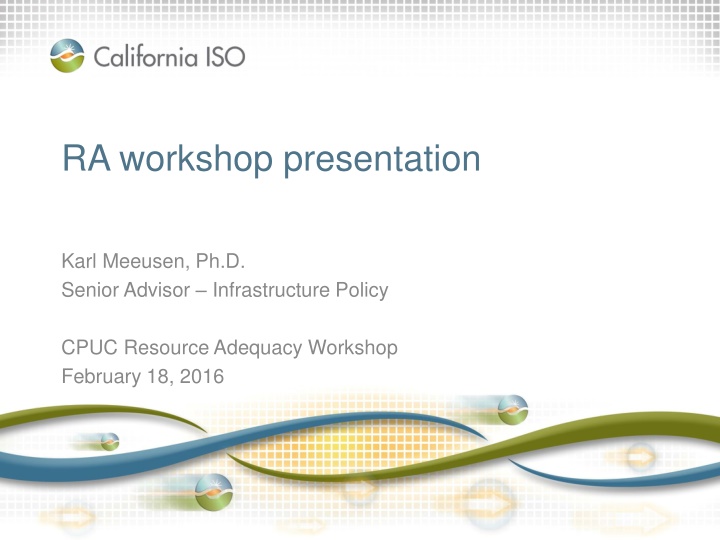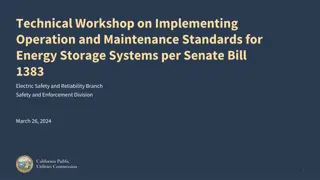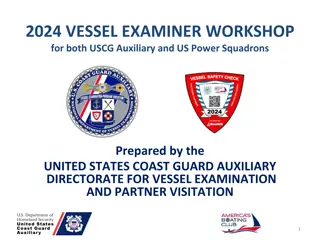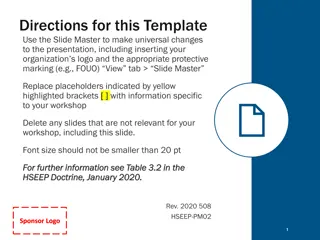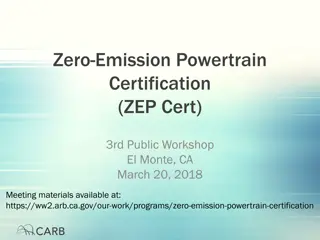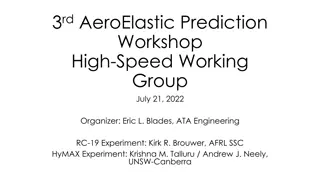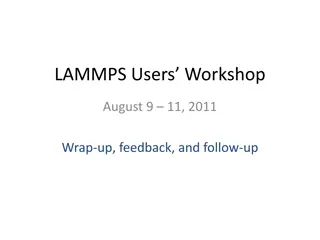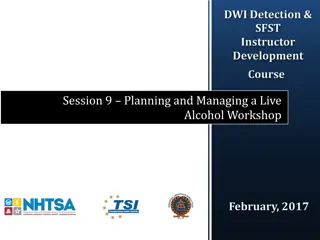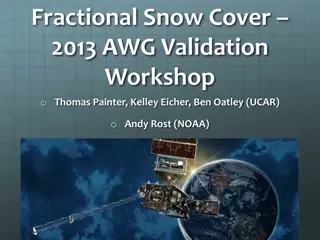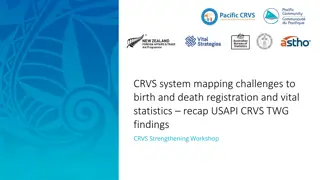RA workshop presentation
"This presentation by Dr. Karl Meeusen at the CPUC Resource Adequacy Workshop on February 18, 2016, delves into infrastructure policy and senior advisory insights within the energy sector. Discover key perspectives and strategies discussed around resource adequacy for informed decision-making."
Download Presentation

Please find below an Image/Link to download the presentation.
The content on the website is provided AS IS for your information and personal use only. It may not be sold, licensed, or shared on other websites without obtaining consent from the author.If you encounter any issues during the download, it is possible that the publisher has removed the file from their server.
You are allowed to download the files provided on this website for personal or commercial use, subject to the condition that they are used lawfully. All files are the property of their respective owners.
The content on the website is provided AS IS for your information and personal use only. It may not be sold, licensed, or shared on other websites without obtaining consent from the author.
E N D
Presentation Transcript
RA workshop presentation Karl Meeusen, Ph.D. Senior Advisor Infrastructure Policy CPUC Resource Adequacy Workshop February 18, 2016
Summary of the ISO comments The ISO recommends the Commission align its resource adequacy program with the ISO s planning standards and North American Mandatory Standards As a NERC-registered entity, the ISO must comply with all Applicable Reliability Criteria under its FERC- approved Transmission Control Agreement Local capacity area resource requirements specified in Section 40.3 of the ISO tariff ISO must maintain local capacity reliability under NERC Planning Event 6 (P6, formerly Category C) contingencies Requires sufficient capacity to readjust the system to prepare for the loss of a second transmission element (N-1-1) Page 2
Summary of the ISO comments Based on requirement to reposition the system within 30 minutes, the ISO has two options: 1. By assessing the system and issuing a dispatch instruction and have a response within 20 minutes* 2. By dispatching a resource precontingency so as to have sufficient energy available The ISO has consistently applied these standards in its Local Capacity Technical Studies ISO recently issued a clarification to its BPM providing additional details regarding these study parameters * 10 minutes is used at beginning of contingency. If resources do not respond, the ISO will not meet reliability requirement Page 3
Excerpts from the ISOs Local Capacity Technical Report [I]nputs, assumptions and methodology were discussed and agreed to by stakeholders at the 2016 LCT Study Criteria, Methodology and Assumptions Stakeholder Meeting held on October 30, 2014. Time allowed for manual readjustment: This is the amount of time required for the operator to take all actions necessary to prepare the system for the next contingency. This time should be less than 30 minutes, based on existing CAISO Planning Standards. Page 4
Three scenarios show how ISO can meet NERC requirements for local capacity areas Scenario assumptions for local capacity area A: Multiple transmission lines serve the area Import limit is not binding with all transmission in service With one transmission line out of service, import is limited by system voltage stability so imports must be reduced within 30 minutes Scenarios shown: All resources are fast response All resources are slow response Resources are a mix of fast and slow response Page 5
All fast response When a line trips, call fast response DR or fast-response gas-fired resources Import limit with all lines in service Imports into local capacity area A Stability limit with one transmission line out of service (MW) 30 minutes total (10 for dispatch; 20 for response) Hours in a day Page 6
All slow response Slow resources must be dispatched ahead of time so that flows are below the line limit, regardless if a line trips or not Import limit with all lines in service Imports into local capacity area A Stability limit with one transmission line out of service (MW) This may mean slow resources are committed in the day-ahead market, regardless of whether contingency occurs or not. Hours in a day Page 7
Combination of fast and slow (more likely) With a combination of fast and slow resources, slow resources must be dispatched ahead of time while fast response resources are dispatched after a contingency occurs Import limit with all lines in service Imports into local capacity area A Dispatch slow resources to get within range of fast response Stability limit with one transmission line out of service (MW) 30 minutes total (10 for dispatch; 20 for response) Hours in a day Page 8
Conclusion NERC reliability criteria require the ISO return the system to precontingency conditions within 30 minutes during a P6 contingency The ISO local capacity study utilizes resources that can either receive a dispatch instruction and respond in 30 minutes or be dispatched precontingency to respond in 30 minutes The NERC reliability requirements and the ISO administration of these requirements have not changed for many years The ISO recommends the Commission align its resource adequacy program with the ISO s planning standards and North American Mandatory Standards Page 9
Questions? Page 10
